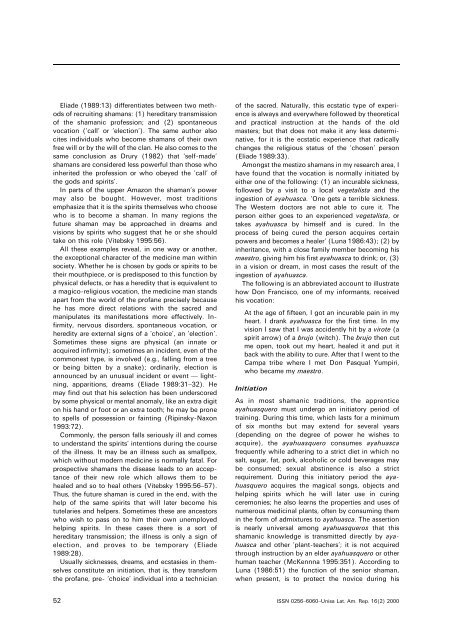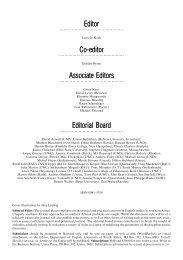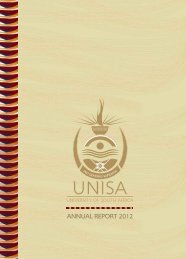pdf: 6.426kb - University of South Africa
pdf: 6.426kb - University of South Africa
pdf: 6.426kb - University of South Africa
You also want an ePaper? Increase the reach of your titles
YUMPU automatically turns print PDFs into web optimized ePapers that Google loves.
Eliade (1989:13) differentiates between two methods<br />
<strong>of</strong> recruiting shamans: (1) hereditary transmission<br />
<strong>of</strong> the shamanic pr<strong>of</strong>ession; and (2) spontaneous<br />
vocation (`call' or `election'). The same author also<br />
cites individuals who become shamans <strong>of</strong> their own<br />
free will or by the will <strong>of</strong> the clan. He also comes to the<br />
same conclusion as Drury (1982) that `self-made'<br />
shamans are considered less powerful than those who<br />
inherited the pr<strong>of</strong>ession or who obeyed the `call' <strong>of</strong><br />
the gods and spirits'.<br />
In parts <strong>of</strong> the upper Amazon the shaman's power<br />
may also be bought. However, most traditions<br />
emphasize that it is the spirits themselves who choose<br />
who is to become a shaman. In many regions the<br />
future shaman may be approached in dreams and<br />
visions by spirits who suggest that he or she should<br />
take on this role (Vitebsky 1995:56).<br />
All these examples reveal, in one way or another,<br />
the exceptional character <strong>of</strong> the medicine man within<br />
society. Whether he is chosen by gods or spirits to be<br />
their mouthpiece, or is predisposed to this function by<br />
physical defects, or has a heredity that is equivalent to<br />
a magico-religious vocation, the medicine man stands<br />
apart from the world <strong>of</strong> the pr<strong>of</strong>ane precisely because<br />
he has more direct relations with the sacred and<br />
manipulates its manifestations more effectively. Infirmity,<br />
nervous disorders, spontaneous vocation, or<br />
heredity are external signs <strong>of</strong> a `choice', an `election'.<br />
Sometimes these signs are physical (an innate or<br />
acquired infirmity); sometimes an incident, even <strong>of</strong> the<br />
commonest type, is involved (e.g., falling from a tree<br />
or being bitten by a snake); ordinarily, election is<br />
announced by an unusual incident or event Ð lightning,<br />
apparitions, dreams (Eliade 1989:31±32). He<br />
may find out that his selection has been underscored<br />
by some physical or mental anomaly, like an extra digit<br />
on his hand or foot or an extra tooth; he may be prone<br />
to spells <strong>of</strong> possession or fainting (Ripinsky-Naxon<br />
1993:72).<br />
Commonly, the person falls seriously ill and comes<br />
to understand the spirits' intentions during the course<br />
<strong>of</strong> the illness. It may be an illness such as smallpox,<br />
which without modern medicine is normally fatal. For<br />
prospective shamans the disease leads to an acceptance<br />
<strong>of</strong> their new role which allows them to be<br />
healed and so to heal others (Vitebsky 1995:56±57).<br />
Thus, the future shaman is cured in the end, with the<br />
help <strong>of</strong> the same spirits that will later become his<br />
tutelaries and helpers. Sometimes these are ancestors<br />
who wish to pass on to him their own unemployed<br />
helping spirits. In these cases there is a sort <strong>of</strong><br />
hereditary transmission; the illness is only a sign <strong>of</strong><br />
election, and proves to be temporary (Eliade<br />
1989:28).<br />
Usually sicknesses, dreams, and ecstasies in themselves<br />
constitute an initiation, that is, they transform<br />
the pr<strong>of</strong>ane, pre- `choice' individual into a technician<br />
<strong>of</strong> the sacred. Naturally, this ecstatic type <strong>of</strong> experience<br />
is always and everywhere followed by theoretical<br />
and practical instruction at the hands <strong>of</strong> the old<br />
masters; but that does not make it any less determinative,<br />
for it is the ecstatic experience that radically<br />
changes the religious status <strong>of</strong> the `chosen' person<br />
(Eliade 1989:33).<br />
Amongst the mestizo shamans in my research area, I<br />
have found that the vocation is normally initiated by<br />
either one <strong>of</strong> the following: (1) an incurable sickness,<br />
followed by a visit to a local vegetalista and the<br />
ingestion <strong>of</strong> ayahuasca. `One gets a terrible sickness.<br />
The Western doctors are not able to cure it. The<br />
person either goes to an experienced vegetalista, or<br />
takes ayahuasca by himself and is cured. In the<br />
process <strong>of</strong> being cured the person acquires certain<br />
powers and becomes a healer' (Luna 1986:43); (2) by<br />
inheritance, with a close family member becoming his<br />
maestro, giving him his first ayahuasca to drink; or, (3)<br />
in a vision or dream, in most cases the result <strong>of</strong> the<br />
ingestion <strong>of</strong> ayahuasca.<br />
The following is an abbreviated account to illustrate<br />
how Don Francisco, one <strong>of</strong> my informants, received<br />
his vocation:<br />
At the age <strong>of</strong> fifteen, I got an incurable pain in my<br />
heart. I drank ayahuasca for the first time. In my<br />
vision I saw that I was accidently hit by a virote (a<br />
spirit arrow) <strong>of</strong> a brujo (witch). The brujo then cut<br />
me open, took out my heart, healed it and put it<br />
back with the ability to cure. After that I went to the<br />
Campa tribe where I met Don Pasqual Yumpiri,<br />
who became my maestro.<br />
Initiation<br />
As in most shamanic traditions, the apprentice<br />
ayahuasquero must undergo an initiatory period <strong>of</strong><br />
training. During this time, which lasts for a minimum<br />
<strong>of</strong> six months but may extend for several years<br />
(depending on the degree <strong>of</strong> power he wishes to<br />
acquire), the ayahuasquero consumes ayahuasca<br />
frequently while adhering to a strict diet in which no<br />
salt, sugar, fat, pork, alcoholic or cold beverages may<br />
be consumed; sexual abstinence is also a strict<br />
requirement. During this initiatory period the ayahuasquero<br />
acquires the magical songs, objects and<br />
helping spirits which he will later use in curing<br />
ceremonies; he also learns the properties and uses <strong>of</strong><br />
numerous medicinal plants, <strong>of</strong>ten by consuming them<br />
in the form <strong>of</strong> admixtures to ayahuasca. The assertion<br />
is nearly universal among ayahuasqueros that this<br />
shamanic knowledge is transmitted directly by ayahuasca<br />
and other `plant-teachers'; it is not acquired<br />
through instruction by an elder ayahuasquero or other<br />
human teacher (McKennna 1995:351). According to<br />
Luna (1986:51) the function <strong>of</strong> the senior shaman,<br />
when present, is to protect the novice during his<br />
52 ISSN 0256±6060±Unisa Lat. Am. Rep. 16(2) 2000

















